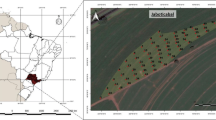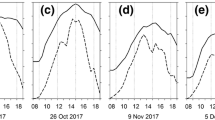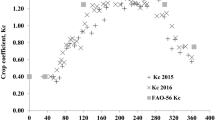Abstract
Canopy reflectance sensors are useful tools for guiding nitrogen fertilization in crops. However, studies of sugarcane comparing the efficiency of different devices for determining crop parameters are scarce. The objective of this study was to compare the performance of canopy sensors in detecting sugarcane variability. Four nitrogen (N) rate experiments were conducted (plots), along with biomass sampling, chlorophyll meter readings and leaf N concentration determination in another four fields by canopy sensor readings guided samplings. The examined canopy sensors were GreenSeeker and two Crop Circle models (ACS-210 and ACS-430), which allowed the calculation of different normalized difference vegetation index (NDVI) configurations. Neither of the canopy sensors showed a correlation with the obtained chlorophyll meter readings (SPAD) or leaf N content within the fields, while high correlations with above-ground biomass were found, indicating that the plant population and vigor interfered with the canopy sensor readings. The devices showed similar suitability in terms of N rate differentiation and correlations with crop parameters. However, the NDVI calculated from the Crop Circle ACS-430 sensor using a red-edge waveband (NDRE) showed the best results, displaying the greatest range of measured values and the highest sensitivity as a biomass predictor. Regardless of the canopy sensor and wavebands used, all of the analyzed sensors proved to be good tools for identifying the variability of crop development in sugarcane fields.



Similar content being viewed by others
References
Amaral, L. R., & Molin, J. P. (2014). The effectiveness of three vegetation indices obtained from a canopy sensor in identifying sugarcane response to nitrogen. Agronomy Journal, 106, 273–280.
Amaral, L. R., Portz, G., Rosa, H. J. A., & Molin, J. P. (2012). Use of active crop canopy reflectance sensor for nitrogen sugarcane fertilization. p. 15. In 11th International Conference on Precision Agriculture.
Baret, F., & Guyot, G. (1991). Potentials and limits of vegetation indices for LAI and APAR assessment. Remote Sensing of Environment, 35, 161–173.
Berntsen, J., Thomsen, A., Schelde, K., Hansen, O. M., Knudsen, L., Broge, N., et al. (2006). Algorithms for sensor-based redistribution of nitrogen fertilizer in winter wheat. Precision Agriculture, 7, 65–83.
Bremner, J. M., & Mulvaney, C. S. (1982). Nitrogen total. pp. 595–624. In Page, A.L. et al. (Ed.), Methods of soil analysis. Part 2. 2nd ed. Agron. Monogr. 9. ASA and SSSA: Madison, WI.
Cao, Q., Miao, Y., Gao, X., Feng, G., & Liu, B. (2012). Performance of two active canopy sensors for estimating winter wheat nitrogen status in North China Plain. In 11th International Conference on Precision Agriculture. Indianapolis.
Eitel, J. U. H., Long, D. S., Gessler, P. E., & Hunt, E. R. (2008). Combined spectral index to improve ground-based estimates of nitrogen status in dryland wheat. Agronomy Journal, 100, 1694–1702.
EMBRAPA - Brazilian Agricultural Research Corporation. Brazilian soil classification system. (2006). (In Portuguese.), 2nd ed. EMBRAPA, Rio de Janeiro, RJ, Brazil.
Erdle, K., Mistele, B., & Schmidhalter, U. (2012). Comparison of active and passive spectral sensors in discriminating biomass parameters and nitrogen status in wheat cultivars. In 11th International Conference on Precision Agriculture.
FAO. (2011). Food and Agriculture Organization. Faostat. http://faostat.fao.org/. Accessed 27 Aug. 2014.
Ferreira, D. F. (2011). SISVAR: a computer statistical analysis system. Ciência e Agrotecnologia, 35, 1039–1042.
Franco, H. C. J., Trivelin, P. C. O., Faroni, C. E., Vitti, A. C., & Otto, R. (2010). Stalk yield and technological attributes of planted cane as related to nitrogen fertilization. Scientia Agricola, 67, 579–590.
Freeman, K. W., Girma, K., Arnall, D. B., Mullen, R. W., Martin, K. L., Teal, R. K., et al. (2007). By-plant prediction of corn forage biomass and nitrogen uptake at various growth stages using remote sensing and plant height. Agronomy Journal, 99, 530–536.
Holland, K. H., & Schepers, J. S. (2010). Derivation of a variable rate nitrogen application model for in-season fertilization of corn. Agronomy Journal, 102, 1415–1424.
Hong, S. D., Schepers, J. S., Francis, D. D., & Schlemmer, M. R. (2007). Comparison of ground based remote sensors for evaluation of corn biomass affected by nitrogen stress. Communications in Soil Science and Plant Analysis, 38, 2209–2226.
Jarrell, W. M., & Beverly, R. B. (1981). The dilution effect in plant nutrition studies. Advances in Agronomy, 34, 197–224.
Kitchen, N. R., Sudduth, K. A., Drummond, S. T., Scharf, P. C., Palm, H. L., Roberts, D. F., et al. (2010). Ground-based canopy reflectance sensing for variable-rate nitrogen corn fertilization. Agronomy Journal, 102, 71–84.
Lofton, J., Tubana, B. S., Kanke, Y., Teboh, J., Viator, H., & Dalen, M. (2012). Estimating sugarcane yield potential using an in-season determination of normalized difference vegetative index. Sensors, 12, 7529–7547.
Lukina, E., Freeman, K., Wynn, K., Thomason, W., Mullen, R., Stone, M., et al. (2001). Nitrogen fertilization optimization algorithm based on in-season estimates of yield and plant nitrogen uptake. Journal of Plant Nutrition, 24, 885–898.
Molin, J. P., Frasson, F. R., Amaral, L. R., Povh, F. P., & Salvi, J. V. (2010). Capability of an optical sensor in verifying the sugarcane response to nitrogen rates.(In Portuguese, with English abstract). Revista Brasileira de Engenharia Agrícola e Ambiental, 14, 1345–1349.
Osborne, S. L. (2007). Utilization of existing technology to evaluate spring wheat growth and nitrogen nutrition in South Dakota. Communications in Soil Science and Plant Analysis, 38, 949–958.
Portz, G., Molin, J. P., & Jasper, J. (2011). Active crop sensor to detect variability of nitrogen supply and biomass on sugarcane fields. Precision Agriculture, 13, 33–44.
Prado, R. M., & Pancelli, M. A. (2008). Sugarcane ratoon response to nitrogen application in a no burn harvesting system. (In Portuguese, with English abstract.). Bragantia, 67, 951–959.
Raun, W., Solie, J., Stone, M., Martin, K., Freeman, K., Mullen, R., et al. (2005). Optical sensor-based algorithm for crop nitrogen fertilization. Communications in Soil Science and Plant Analysis, 36, 2759–2781.
Shaver, T. M., Khosla, R., & Westfall, D. G. (2010). Evaluation of two ground-based active crop canopy sensors in maize: growth stage, row spacing, and sensor movement speed. Soil Science Society of America Journal, 74, 2101–2108.
Shaver, T. M., Khosla, R., & Westfall, D. G. (2011). Evaluation of two crop canopy sensors for nitrogen variability determination in irrigated maize. Precision Agriculture, 12, 892–904.
Shiratsuchi, L. S., Ferguson, R. B., Shanahan, J. F., Adamchuk, V. I., & Slater, G. P. (2010). Comparision of spectral indices derived from active crop canopy sensors for assessing nitrogen and water status. In 10th International Conference on Precision Agriculture. Denver, CO.
Solari, F., Shanahan, J., Ferguson, R., Schepers, J., & Gitelson, A. (2008). Active sensor reflectance measurements of corn nitrogen status and yield potential. Agronomy Journal, 100, 571–579.
Solie, J. B., Monroe, A. D., Raun, W. R., & Stone, M. L. (2012). Generalized algorithm for variable-rate nitrogen application in cereal grains. Agronomy Journal, 104, 378–387.
Sudduth, K. A., Kitchen, N. R., & Drummond, S. T. (2010). Comparison of three canopy reflectance sensors for variable-rate nitrogen application in corn. In 10th International Conference on Precision Agriculture. Denver, CO.
Taubinger, L., Amaral, L. R., & Molin, J. P. (2012). Vegetation indices from active crop canopy sensor and their potential interference factors on sugarcane. p. 13. In 11th International Conference on Precision Agriculture.
Teal, R. K., Tubana, B., Girma, K., Freeman, K. W., Arnall, D. B., Walsh, O., et al. (2006). In-season prediction of corn grain yield potential using normalized difference vegetation index. Agronomy Journal, 98, 1488–1494.
Tremblay, N., Wang, Z., Ma, B., Belec, C., & Vigneault, P. (2008). A comparison of crop data measured by two commercial sensors for variable-rate nitrogen application. Precision Agriculture, 10, 145–161.
Varvel, G. E., Schepers, J. S., & Francis, D. D. (1997). Ability for in-season correction of nitrogen deficiency in corn using chlorophyll meters. Soil Science Society of America Journal, 61, 1233–1239.
Viña, A., & Gitelson, A. A. (2005). New developments in the remote estimation of the fraction of absorbed photosyntetically active radiation in crops. Geophysical Research Letters, 32, 1–4.
Acknowledgments
This work would not have been possible without the collaboration of São Martinho’s Mill team and Máquinas Agrícolas Jacto. We acknowledge the Research and Projects Financing (FINEP) received from the Ministry of Science and Technology, through the PROSENSAP project for financial support and the São Paulo Research Foundation (FAPESP) for providing a doctoral scholarship to the first author. We also thank the Agronomic Institute of Campinas (IAC) and Dr. Heitor Cantarella for making available some of their experimental trials.
Author information
Authors and Affiliations
Corresponding author
Rights and permissions
About this article
Cite this article
Amaral, L.R., Molin, J.P., Portz, G. et al. Comparison of crop canopy reflectance sensors used to identify sugarcane biomass and nitrogen status. Precision Agric 16, 15–28 (2015). https://doi.org/10.1007/s11119-014-9377-2
Published:
Issue Date:
DOI: https://doi.org/10.1007/s11119-014-9377-2




